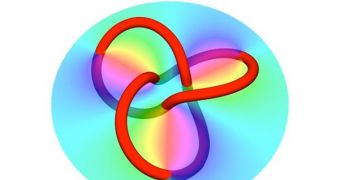One of the things most people know about light is that it tends to travel in a straight line. This is made obvious by the fact that when you place your hand between a source of light and your face, you no longer see the light. If photons were to be traveling in a chaotic manner, without a sense of direction, then we would be able to see the light source even with our hand between it and our eyes. But now, researchers at the University of Bristol in England announce that they were able to create light knots, pretzel-like features similar to the ones that can be made out of shoe laces.
In their investigation, the team used nothing more than a computerized hologram, and some advanced theoretical physics, to get the job done. The amazing achievement could have some fairly interesting applications in physics in the near future, and especially for laser devices, the UB researchers believe. In addition to the wonderfully peculiar images that were generated via the new model, new and exciting features could be produced in light-handling devices. Lead study researcher Mark Dennis likens the flow of laser light through space to the flow of water through a river. While, most of the time, the water does flow in a straight line, on other occasions it whirls and eddies, Dennis reveals.
In a light beam, these swirls are called optical vortices, and feature an intensity that tends toward zero. “The light all around us is filled with these dark lines, even though we can't see them. Our work actually twists dark filaments within the light beam into knots,” the UB expert adds.
The optical vortices themselves were created with a custom hologram, as these structures are known to be able to redirect light waves in intricate manners. The holograms themselves were constructed based on the fibered knot theory, a highly complex branch of abstract mathematics that is based on the traits of average knots, LiveScience reports.
“The hologram acts like a filter for incoming light, similar to the stained glass window in a church. After going through a stained glass window, the light has taken on the pattern of colors of the window. Whilst the stained glass window manipulates color, the hologram manipulates the phase of the light wave,” Dennis adds.
Details of the team's approach and successes appear in the January 17 online issue of the respected scientific journal Nature Physics. “For me, [this research] shows how physicists can adapt existing pure mathematics, such as knot theory, and find it manifest in physical phenomena. It also shows how finely we can control the flow and propagation of laser light using holograms. This degree of control is likely to find applications in future laser devices,” Dennis concludes.

 14 DAY TRIAL //
14 DAY TRIAL //